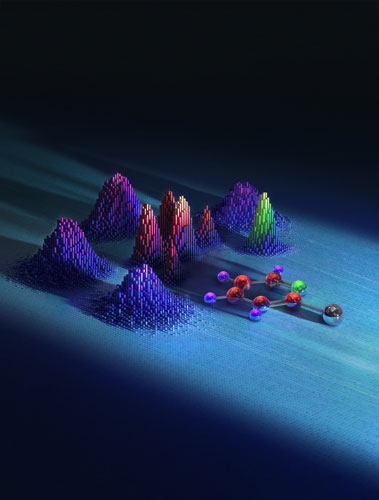March 7, 2022
K-State physicists publish on X-ray lasers taking pictures of complex molecules

K-State physicists Daniel Rolles and Artem Rudenko, and their graduate student, Xiang Li, are part of an international research team that has published the article "X-ray multiphoton-induced Coulomb explosion images complex single molecules" in Nature Physics, a monthly journal publishing the highest-quality research in all areas of physics, pure and applied.
The team used the world's largest X-ray laser, the European XFEL, to take pictures of complex molecules. With ultra-bright X-ray flashes, the scientists were able to take snapshots of gas-phase iodopyridine molecules with atomic resolution. In the process, the molecules are exploded by the X-ray laser, and the image is reconstructed from the pieces.
In the method known as Coulomb explosion imaging, a high-intensity and ultra-short X-ray laser pulse knocks out numerous electrons from the molecule. Due to the strong electrostatic repulsion between the remaining, positively charged atoms, the molecule explodes within a few femtoseconds — the millionths of a billionth of a second, the individual atoms fly apart and are registered by a detector.
"Our group and many other researchers have been doing similar Coulomb explosion imaging experiments for a while, but we have never been able to take such crisp and clear images of such a relatively large molecule with this technique before," Rolles said.
"One of the key points here is that we can see all hydrogen atoms, which are hard to image by more conventional techniques like X-ray or electron diffraction," adds Rudenko.
The work published in Nature Physics is part of a broader effort to develop this new imaging technique.
"Recently, our collaboration published a closely-related paper in Physical Review Research, led by our graduate student, Xiang Li, where we have shown that for somewhat simpler molecules, even the full 3D structure can be captured," Rudenko said.
The images are an important step toward recording molecular movies, which researchers hope to use in the future to observe details of biochemical, chemical and physical reactions with high resolution.
"Seeing how well this works with the extremely short X-ray pulses from an X-ray free-electron laser such as the European XFEL got us really excited about the prospect of being able to take molecular movies of photochemical reactions in complex molecules that are a bit more exciting than simple diatomics or triatomics, and are relevant for many technological applications," Rolles said.
This realization is particularly timely since the SLAC National Lab in Stanford is about to start its upgraded high-repetition-rate X-ray laser, LCLS-2 this fall, which will deliver 1,000 times more pulses per second than the current version used so far. Combing these incredibly high repetition rates with the demonstrated Coulomb explosion imaging technique promises to revolutionize the field of molecular "movie making," which will benefit such important technological areas as solar energy conversion, photocatalysis and artificial photosynthesis.
"We have recently received more than $1.1 million in funding from the National Science Foundation to purchase a high repetition rate, 100-kHz femtosecond laser for our lab here at K-State," Rudenko said. "With this new laser and the things we have learned about Coulomb explosion imaging, we are hoping to be able to take similar movies here as well."
Rolles and Rudenko work at the J.R. Macdonald Laboratory at the K-State physics department, which is one of the most active centers for atomic, molecular and optical physics in the United States. Similar to SLAC, the lab is funded by the U.S. Department of Energy. Li is now working at SLAC National Accelerator Laboratory.
The work was performed by a large international research team led by Rebecca Boll from the European XFEL, which included researchers from the universities of Hamburg, Frankfurt, and Main and Kassel, Jiao Tong University in Shanghai, Kansas State University, the Max Planck Institutes for Medical Research and for Nuclear Physics, the Fritz Haber Institute of the Max Planck Society, the U.S. accelerator center SLAC, the Hamburg Cluster of Excellence CUI: Advanced Imaging of Matter, the Center for Free-Electron Laser Science at DESY, DESY and European XFEL.
